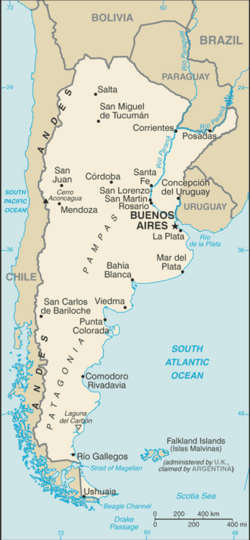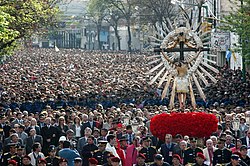This is an old revision of this page, as edited by 210.117.176.50 (talk) at 07:02, 16 April 2014. The present address (URL) is a permanent link to this revision, which may differ significantly from the current revision.
Revision as of 07:02, 16 April 2014 by 210.117.176.50 (talk)(diff) ← Previous revision | Latest revision (diff) | Newer revision → (diff)

The Catholic Church in Argentina is part of the worldwide Roman Catholic Church, under the spiritual leadership of the Pope, the Curia in Rome, and the Argentine Episcopal Conference.
There are an estimated 33 million baptised Roman Catholics in Argentina, roughly 89% of the population. According to a 1999 study, 78% of Argentinians call themselves Catholics, though many of these are nominal Catholics who only attend church on specific social occasions (weddings, baptism ceremonies, etc.). According to the CIA Factbook, 92% of the country are Catholic, but only 20% practice their faith regularly (i.e., attend Mass every single Sunday throughout the Liturgical Year).
Today, the church in Argentina is divided into administrative territorial units called dioceses and archdioceses. Buenos Aires, for example, is a metropolitan archdiocese owing to its size and historical significance as the capital of the nation. An archbishop of Buenos Aires, Cardinal Jorge Bergoglio, SJ, was elected Pope on 13 March 2013. Buenos Aires Metropolitan Cathedral, the seat of the archbishop, also houses the remains of General José de San Martín in a mausoleum.
There are seven Catholic universities in Argentina: Pontifical Catholic University of Argentina (Buenos Aires), the Universidad Católica de Córdoba, the Universidad de La Plata, the Universidad de Salta, the Universidad de Santa Fe, the Universidad de Cuyo, and the Catholic University of Santiago del Estero. Religious orders run and sponsor hundreds of primary and secondary schools throughout the country, with government funding.
History
Colonial and Early Republican Period
During the Spanish colonial period, the Catholic Church became the dominant religious presence and social service provider in the Spanish holdings in South America, including the territory that would later become independent Argentina. Following independence from Spain in 1810, there were sharp disagreements within the national ruling elite over the degree of Church influence in the country. Not wanting to offend Spain, the Papacy condemned the revolutions sweeping South America at the time, creating a contentious relationship with the budding Argentine nation. Still, the first Argentine Constitution, promulgated in 1853 and which remains the basis of Argentina’s modern legal system, reserved a special place for the Catholic Church in the country through state financial support while also allowing religious freedom. Church-State relations in the 19th century were characterized by a series of conflicts between the Argentine government and the Church over the issues of compulsory secular education, civil marriage, and the governmental appointment of religious authorities. Argentina and the Holy See broke off diplomatic relations in the 1880s over these issues and went nearly 20 years before reestablishing them. Relations improved during the early 20th century, as various conservative administrations worked with the Vatican to set the basis for a mutually acceptable relationship, which involved, among other things, state permissiveness toward religious education in public schools.
Perón and the military regimes
By the 1950s, the increasing power of Juan Domingo Perón produced tensions between his administration and the Church over issues such as the attempted legalization of divorce and prostitution, and particularly state regulation of religious education. These culminated in an open confrontation between the two, which paved the way for a military coup against the regime by discontented and largely Catholic-inspired factions of the military in 1955. During the three subsequent decades, relations between Church and State were marked by conflict over human rights abuses and economic injustices endemic to the country’s succession of military-led dictatorships. The 1966 Concordat formalized relations between Argentina and the Vatican and specified Vatican control over appointments of religious authorities in the country. A brief return to democracy in 1973 gave way to increasing political violence and polarization, leading to another coup in 1976. The period following this latter coup was known as the Dirty War, which was characterized by serious and constant violations of human rights by the government as it sought to eliminate leftist opposition. The stance adopted by Church authorities during this period was ambivalent, ranging from the outspoken criticism of a few bishops to open support for the military’s efforts by a few others. The Church’s mixed ethical record through this period continues to haunt debates about the role of the Church in politics to this day.
Recent developments
With the return to democracy in 1983, there was a return to prior debates, including divorce, remarriage, and the status of children born outside of wedlock. Disagreement on these topics was strongest during the administration of Raúl Alfonsín, but thereafter relations between governments and the Church remained generally amicable. During his presidency, Carlos Menem was vocal in his support for the Vatican’s position on abortion, declaring March 25 the “Day of the Unborn Child,” and was recognized by Pope John Paul II for his dedication to this cause, though several of Argentina’s preeminent bishops condemned his economic policies for the poverty they created. Relations between Church and state experienced some tension after the election of Néstor Kirchner in 2003. His administration clashed with Church authorities sharply over issues of abortion, contraception, and sex education, and castigated the Church for its willingness to accommodate the military regime during the 1970s and early 1980s. Kirchner was succeeded by his wife, Cristina Fernández, in 2007.
Contemporary affairs
President Cristina Fernández de Kirchner’s relationship with Argentina’s Catholic Church has been strained due to her outspoken support for homosexual marriage and the perceived leftism of her government’s agenda. In July 2010, Argentina’s Senate legalized same-sex marriage at the urging of President Kirchner. The Catholic Church, together with Evangelical and Protestant groups, organized massive protests against the legislation. The former Archbishop of Buenos Aires and current pope, Jorge Bergoglio, also issued a plea to lawmakers to oppose the vote calling the effort “a move by the father of lies to confuse and deceive the children of God.” Argentina’s Synod of Bishops, in a rare political statement, called upon Catholics to oppose politicians who supported the bill. Kirchner called the Church’s tactics “medieval,” and publicly snubbed the Church by declining to attend the Independence Day Mass, which is considered a ceremonial tradition. Despite these public disputes, the Argentinean government has also been criticized from the left for its close institutional relationship with the Catholic Church, the only religion in the country to enjoy official recognition. In September 2010, ten thousand Argentineans marched in Buenos Aires to protest the perceived corporate structure of the state and its corrupt ties with business interests, the military, and the Catholic Church. The march’s organizer, university professor and political activist Luis D’Elía, proclaimed it “a disgrace that Catholic schools received state subsidies.”
Pastoral regions
- Región Noroeste (NOA) (Northeast Region)
- Región Noreste (NEA) (Northwest Region)
- Región de Cuyo (Cuyo Region)
- Región Centro (Central Region)
- Región Litoral (Littoral Region)
- Región Buenos Aires (Buenos Aires Region)
- Región Platense (Platense Region)
- Región Patagonia-Comahue (Patagonia–Comahue Region)
Divisions by region
- Northwest — 10 dioceses: Añatuya, Cafayate, Catamarca, Concepción, Humahuaca, Jujuy, Orán, Salta, Santiago del Estero, and Tucumán
- Northeast — 9 dioceses: Corrientes, Formosa, Goya, Posadas, Puerto Iguazú, Reconquista, Resistencia, Santo Tomé, San Roque
- Cuyo — 5 dioceses: La Rioja, Mendoza, San Rafael, San Juan de Cuyo, San Luis
- Central — 6 dioceses: Córdoba, Cruz del Eje, Deán Funes, San Francisco, Villa de la Concepción del Río Cuarto, Villa María; Greek Melkite Exarchy
- Littoral — 7 dioceses: Concordia, Gualeguaychú, Paraná, Rafaela, Rosario, Santa Fe de la Vera Cruz, Venado Tuerto
- Buenos Aires — 11 dioceses: Avellaneda–Lanús, Buenos Aires, Gregorio de Laferrere, Lomas de Zamora, Merlo-Moreno, Morón, Quilmes, San Isidro, San Martín, San Miguel, San Justo; Military Bishopric; Oriental Ordinariate; 3 eparchies: Armenian Eparchy, Maronite Eparchy, Ukrainian Eparchy
- Platense — 10 dioceses: Azul, Bahía Blanca, Chascomús, La Plata, Mar del Plata, Mercedes–Luján, San Nicolás, Santa Rosa, Zárate-Campana
- Patagonia-Comahue — 6 dioceses: Alto Valle del Río Negro, Comodoro Rivadavia, Neuquén, Río Gallegos, San Carlos de Bariloche, Viedma
See also
- List of the Roman Catholic dioceses of Argentina
- Religion in Argentina
- State-Church relations in Argentina
- List of South American Saints
Notes
- CIA FACTBOOK, 2009
References
- Pastoral Regions of the Catholic Church in Argentina. Website of the Argentine Episcopal Conference.
| Roman Catholicism in South America | |
|---|---|
| Sovereign states | |
| Dependencies and other territories | |